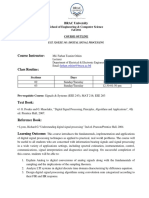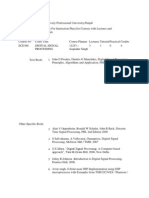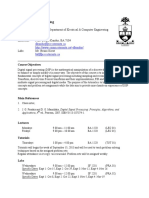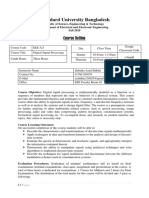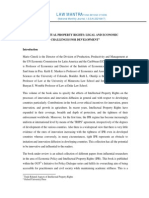Lecture 1 Notes DSP
Uploaded by
gameloonLecture 1 Notes DSP
Uploaded by
gameloonLecture1:Introduction
Thursday,January23,2014 9:24AM
Lecture Notes Page 1
Lecture Notes Page 2
ECE 346: Digital Signal Processing Spring 2014
MTh 8:4010:00 AM, PH115
Instructor Waheed U. Bajwa 723 CoRE, Tel. 848-445-8541 Means of Communication E-Mail: waheed.bajwa@rutgers.edu Twitter: @SigProcessing (#RUECE346) YouTube Channel: SigProcessing Course Website: http://www.rci.rutgers.edu/wub1/courses/ece346sp14.html Sakai: https://sakai.rutgers.edu/portal/site/0c4b9cc3-6c28-4924-8fc8-60b452d5c84d Ofce Hours Ofce Hours: M 10:1511:00 AM Additional Ofce Hours: By appointment via http://doodle.com/bajwa Teaching Assistants Names and emails of the TAs and their ofce hours and ofce location will be announced via the Sakai mailing list. Please make sure that your email is up-to-date on Sakai. Required Text Sanjit K. Mitra, Digital Signal Processing: A Computer-Based Approach, 4/e McGraw-Hill (ISBN-13: 978-0077366766) Caution: Some homework/practice problems might be assigned from the text. Please match your books ISBN with the ISBN listed above or consult with the library reserve to ensure you will be solving the right problem. Reference Text (not required) James H. McClellan, Ronald W. Schafer, and Mark A. Yoder, Signal Processing First, Prentice Hall (highly recommended for students with weak understanding of the prerequisites) Prerequisites The courses ECE 345 (and ECE 347) Linear Systems and Signals (and Lab). In particular, enrolled students should be comfortable with the concepts of complex numbers, Fourier, Laplace, and z transforms, continuous and discrete signals and systems, time-domain and frequency-domain relationships between the input and output of linear, timeinvariant (LTI) systems, continuous and discrete convolutions, etc. The students are also expected to be comfortable with the use of MATLAB for assignments/projects.
Course Policies The nal course grade will be based upon: 1. Pre-requisite quiz (2%) 2. Random attendance (3%) 3. Sakai quizzes (5%) 4. Homework (5%) 5. Team project (10%) 6. Two in-class exams (40%) 7. Final exam (35%) Random attendance policy: Because of its convoluted nature :), it will be explained in the rst lecture. Late homework submission policy: Every student gets a grace period of up to 3 days for a maximum of two homeworks. Utilization of the rst grace period is without any penalty. Utilization of the second grace period comes with a 30% penalty. No late submissions will be accepted from a student who has utilized both these grace periods. Quiz makeup policy: As a general policy, no extensions will be provided for online quizzes. However, rules are meant to be broken :), so feel free to bring up any special circumstances to my knowledge and I will be happy to review the extension requests on a case-by-case basis. Exam policy: Exams will be closed book and closed notes. Students can bring in two, two-sided letter-sized pages for midterm exams and four, two-sided letter-sized pages for the nal exam. As a general policy, there will be no makeup exams. I will allow exceptions for rare emergency situations, but this would require at least 7 days advance approval to skip an exam. Any one not appearing in an exam without such prior approval will automatically get a 0. Grading policy: Grades will be assigned on a relative basis. The relative scale though will vary based upon the performance of the overall class. In an ideal setting, students above class average will get B and higher and students below class average will get C+ and lower. If the class performs really well, however, then the B will turn into B+ (or even A!). Similarly, if the class performs really bad then the B will turn into C+ (or even C). Some tips for making learning the class material easier Lets admit it, digital signal processing is a hard class. But we can work together in a team to make it a fun and enjoyable class. I will work hard to achieve this goal, but all of you have to work equally hard to make this a reality. Here are some tips that I hope you will remember to ensure you have a good learning experience throughout the class. If you feel lost during the class, please reach out to the instructor and/or the TAs during their ofce hours. You will be surprised to know that the instructor does not turn into a monster during ofce hours :). Because of the mathematically intensive nature of the course, one cannot learn it by forgetting about it till it is time for an exam. It is therefore important that you try to keep up with the class material on a regular basis. Class lectures are not enough to learn everything about the course. Reading material and sample problems (ungraded) will be assigned on a regular basis to help you learn all the important aspects of the course. Please make sure you keep up with these things, which will be communicated via email and via the course website. While the percentage of the grade assigned to quizzes and homeworks is small, these two categories are going to teach you the most and ensure that you do well on the exams. The purpose of keeping the percentage small is that you dont feel pressured to blindly cheat from other students. You are encouraged to discuss things with others, but you will be doing yourself a big favor by doing the homeworks and quizzes in the end by yourself. 2
Tentative Course Outline Week 1Introduction to signal processing and review of key pre-requisite concepts Weeks 2-6Sampling of continuous-time (CT) signals, aliasing, sampling theorem, reconstruction & antialiasing lters, discrete-time Fourier transform (DTFT), properties of the DTFT, discrete-time (DT) processing of CT signals, nite impulse response (FIR) and innite impulse response (IIR) DT, LTI systems, convolution in the matrixvector form, tapped delay line model of FIR lters, digital processing of analog signals, A/D and D/A conversion, and quantization error Weeks 7-11Discrete Fourier transform (DFT), properties of the DFT, linear convolution using the DFT, fast Fourier transform (FFT), and spectral analysis of signals using the DFT Weeks 12-14 Analysis of LTI systems using the z-transform and the polezero diagram, realizations of lters in direct form I and direct form II, realizations of lters in cascade and parallel form, design of digital lters and IIR lter design using impulse invariance, and FIR lter design using the windowing method
You might also like
- Digital SAT Preview: What to Expect + Tips and StrategiesFrom EverandDigital SAT Preview: What to Expect + Tips and Strategies5/5 (4)
- Course Syllabus: Ee483 - Introduction To Digital Signal ProcessingNo ratings yetCourse Syllabus: Ee483 - Introduction To Digital Signal Processing7 pages
- UT Dallas Syllabus For Ee6360.501 06f Taught by Issa Panahi (Imp015000)No ratings yetUT Dallas Syllabus For Ee6360.501 06f Taught by Issa Panahi (Imp015000)6 pages
- Course Outline For ENGR 305 Linear System Analysis: San Francisco State University Electrical EngineeringNo ratings yetCourse Outline For ENGR 305 Linear System Analysis: San Francisco State University Electrical Engineering4 pages
- UT Dallas Syllabus For Ee6360.001 05f Taught by Louis Hunt (Hunt)No ratings yetUT Dallas Syllabus For Ee6360.001 05f Taught by Louis Hunt (Hunt)2 pages
- v.3 9 September 2014: Prof. A. A. (Louis) Beex Beex@vt - Edu Lindner@vt - EduNo ratings yetv.3 9 September 2014: Prof. A. A. (Louis) Beex Beex@vt - Edu Lindner@vt - Edu4 pages
- University OTAWWA RPP 1 LEMBAR - ELG3175-syl-2015No ratings yetUniversity OTAWWA RPP 1 LEMBAR - ELG3175-syl-20152 pages
- Signal and system analysis course_outlineNo ratings yetSignal and system analysis course_outline5 pages
- EC3500 - Analysis of Random Signals: HTTP://WWW - Itl.nist - Gov/div898/handbook/edaNo ratings yetEC3500 - Analysis of Random Signals: HTTP://WWW - Itl.nist - Gov/div898/handbook/eda2 pages
- Iqra University: Asian Institute of Computer ScienceNo ratings yetIqra University: Asian Institute of Computer Science5 pages
- ECE F434 Digital Signal Processing I Sem 15-16 HONo ratings yetECE F434 Digital Signal Processing I Sem 15-16 HO3 pages
- EE-232 Signals and Systems Ver1.2 - Sp20No ratings yetEE-232 Signals and Systems Ver1.2 - Sp204 pages
- Syllabus EET 4190C - Digital Signal Processing - CRN 16952 - Fall 2012No ratings yetSyllabus EET 4190C - Digital Signal Processing - CRN 16952 - Fall 20124 pages
- ME Communication Systems R 2007 SyllabusNo ratings yetME Communication Systems R 2007 Syllabus27 pages
- Lovely Professional University, Punjab: Format For Instruction Plan (For Courses With Lectures and Tutorials)No ratings yetLovely Professional University, Punjab: Format For Instruction Plan (For Courses With Lectures and Tutorials)9 pages
- Digital Signal Processing ECE455F: Fall 2016No ratings yetDigital Signal Processing ECE455F: Fall 20163 pages
- Bece301l Digital-Signal-Processing TH 1.0 71 Bece301l 66 AcpNo ratings yetBece301l Digital-Signal-Processing TH 1.0 71 Bece301l 66 Acp2 pages
- EE 210 - 01 - Linear Systems Theory (Fall 2020) : San José State University Department of Electrical EngineeringNo ratings yetEE 210 - 01 - Linear Systems Theory (Fall 2020) : San José State University Department of Electrical Engineering6 pages
- CS314 Fall 2014 Assignment 2 Due Wednesday, September 24, 11:59pm Submission: PDF File Through Sakai - Rutgers.eduNo ratings yetCS314 Fall 2014 Assignment 2 Due Wednesday, September 24, 11:59pm Submission: PDF File Through Sakai - Rutgers.edu2 pages
- Lecture 2: Remainder of Introduction: Monday, January 27, 2014 8:44 AMNo ratings yetLecture 2: Remainder of Introduction: Monday, January 27, 2014 8:44 AM6 pages
- CS314 Fall 2014 Assignment 1 Due Wednesday, September 17, 11:59pm Submission: PDF File Through Sakai - Rutgers.eduNo ratings yetCS314 Fall 2014 Assignment 1 Due Wednesday, September 17, 11:59pm Submission: PDF File Through Sakai - Rutgers.edu3 pages
- Comprehensive Systematic Review On Virtual Reality For Cultural Heritage Practices Coherent Taxonomy and MotivationsNo ratings yetComprehensive Systematic Review On Virtual Reality For Cultural Heritage Practices Coherent Taxonomy and Motivations17 pages
- Intellectual Property Rights: Legal and Economic Challenges For DevelopmentNo ratings yetIntellectual Property Rights: Legal and Economic Challenges For Development4 pages
- 30-Longest Increasing Subsequence-22-03-2024No ratings yet30-Longest Increasing Subsequence-22-03-202423 pages
- Software Engineering: User Interface DesignNo ratings yetSoftware Engineering: User Interface Design14 pages
- IMC Unit 1 Mock Exam 2 V17 June 2020 Final Version 11No ratings yetIMC Unit 1 Mock Exam 2 V17 June 2020 Final Version 1125 pages
- 上海外语口译证书培训与考试系列丛书·英语中级口译证书考试中级口译教程 (第四版) (梅德明) (Z-Library) -1No ratings yet上海外语口译证书培训与考试系列丛书·英语中级口译证书考试中级口译教程 (第四版) (梅德明) (Z-Library) -1697 pages
- Characterization of The Radiation Tolerant ToASt ASIC For The Readout of The PANDA MVD Strip DetectorNo ratings yetCharacterization of The Radiation Tolerant ToASt ASIC For The Readout of The PANDA MVD Strip Detector10 pages
- ETG22 - Safe Use of Industrial Organic SolventsNo ratings yetETG22 - Safe Use of Industrial Organic Solvents8 pages
- International Islamic University Islamabad: Faculty of Management SciencesNo ratings yetInternational Islamic University Islamabad: Faculty of Management Sciences3 pages
- Sell ClickBank Products Using Ebay Classified Ads. (PDFDrive)No ratings yetSell ClickBank Products Using Ebay Classified Ads. (PDFDrive)112 pages
- Presentation Report On Union Bank of India: Submitted ToNo ratings yetPresentation Report On Union Bank of India: Submitted To23 pages
- Digital SAT Preview: What to Expect + Tips and StrategiesFrom EverandDigital SAT Preview: What to Expect + Tips and Strategies
- Course Syllabus: Ee483 - Introduction To Digital Signal ProcessingCourse Syllabus: Ee483 - Introduction To Digital Signal Processing
- UT Dallas Syllabus For Ee6360.501 06f Taught by Issa Panahi (Imp015000)UT Dallas Syllabus For Ee6360.501 06f Taught by Issa Panahi (Imp015000)
- Course Outline For ENGR 305 Linear System Analysis: San Francisco State University Electrical EngineeringCourse Outline For ENGR 305 Linear System Analysis: San Francisco State University Electrical Engineering
- UT Dallas Syllabus For Ee6360.001 05f Taught by Louis Hunt (Hunt)UT Dallas Syllabus For Ee6360.001 05f Taught by Louis Hunt (Hunt)
- v.3 9 September 2014: Prof. A. A. (Louis) Beex Beex@vt - Edu Lindner@vt - Eduv.3 9 September 2014: Prof. A. A. (Louis) Beex Beex@vt - Edu Lindner@vt - Edu
- EC3500 - Analysis of Random Signals: HTTP://WWW - Itl.nist - Gov/div898/handbook/edaEC3500 - Analysis of Random Signals: HTTP://WWW - Itl.nist - Gov/div898/handbook/eda
- Iqra University: Asian Institute of Computer ScienceIqra University: Asian Institute of Computer Science
- Syllabus EET 4190C - Digital Signal Processing - CRN 16952 - Fall 2012Syllabus EET 4190C - Digital Signal Processing - CRN 16952 - Fall 2012
- Lovely Professional University, Punjab: Format For Instruction Plan (For Courses With Lectures and Tutorials)Lovely Professional University, Punjab: Format For Instruction Plan (For Courses With Lectures and Tutorials)
- Bece301l Digital-Signal-Processing TH 1.0 71 Bece301l 66 AcpBece301l Digital-Signal-Processing TH 1.0 71 Bece301l 66 Acp
- EE 210 - 01 - Linear Systems Theory (Fall 2020) : San José State University Department of Electrical EngineeringEE 210 - 01 - Linear Systems Theory (Fall 2020) : San José State University Department of Electrical Engineering
- CS314 Fall 2014 Assignment 2 Due Wednesday, September 24, 11:59pm Submission: PDF File Through Sakai - Rutgers.eduCS314 Fall 2014 Assignment 2 Due Wednesday, September 24, 11:59pm Submission: PDF File Through Sakai - Rutgers.edu
- Lecture 2: Remainder of Introduction: Monday, January 27, 2014 8:44 AMLecture 2: Remainder of Introduction: Monday, January 27, 2014 8:44 AM
- CS314 Fall 2014 Assignment 1 Due Wednesday, September 17, 11:59pm Submission: PDF File Through Sakai - Rutgers.eduCS314 Fall 2014 Assignment 1 Due Wednesday, September 17, 11:59pm Submission: PDF File Through Sakai - Rutgers.edu
- Comprehensive Systematic Review On Virtual Reality For Cultural Heritage Practices Coherent Taxonomy and MotivationsComprehensive Systematic Review On Virtual Reality For Cultural Heritage Practices Coherent Taxonomy and Motivations
- Intellectual Property Rights: Legal and Economic Challenges For DevelopmentIntellectual Property Rights: Legal and Economic Challenges For Development
- IMC Unit 1 Mock Exam 2 V17 June 2020 Final Version 11IMC Unit 1 Mock Exam 2 V17 June 2020 Final Version 11
- 上海外语口译证书培训与考试系列丛书·英语中级口译证书考试中级口译教程 (第四版) (梅德明) (Z-Library) -1上海外语口译证书培训与考试系列丛书·英语中级口译证书考试中级口译教程 (第四版) (梅德明) (Z-Library) -1
- Characterization of The Radiation Tolerant ToASt ASIC For The Readout of The PANDA MVD Strip DetectorCharacterization of The Radiation Tolerant ToASt ASIC For The Readout of The PANDA MVD Strip Detector
- International Islamic University Islamabad: Faculty of Management SciencesInternational Islamic University Islamabad: Faculty of Management Sciences
- Sell ClickBank Products Using Ebay Classified Ads. (PDFDrive)Sell ClickBank Products Using Ebay Classified Ads. (PDFDrive)
- Presentation Report On Union Bank of India: Submitted ToPresentation Report On Union Bank of India: Submitted To






